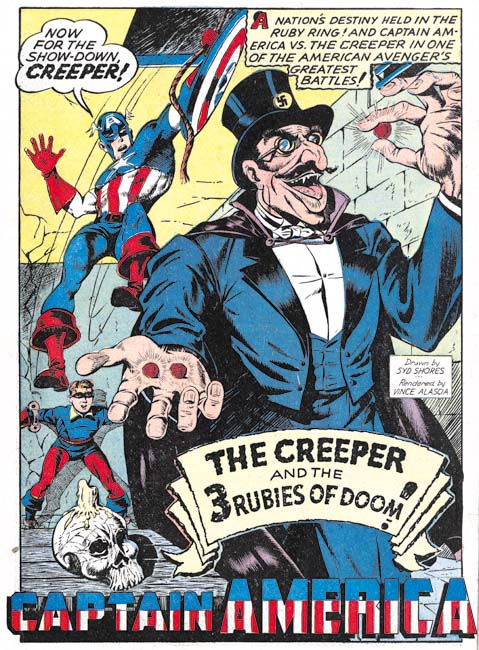
Captain America #21 (December 1942), “The Creeper and the 3 Rubies of Doom”, pencils by Syd Shores, inks by Vince Alascia (signed)
As mentioned in my previous post Captain America #19 was the last issue that Al Avison appeared in before going off to perform military service. Syd Shores assumed Avison’s position as Associate Editor while Stan Lee remained, for a time, Managing and Art Editor. While I admit to being critical of Shores as an inker his pencils are rather nice although not quite as good as Avison. There seems to be quite a bit of problems in the GCD concerning work attributed or misattributed to the two artists. I am not expert in identifying Timely artists but one feature that can often be used to identify Shore’s Captain America and Bucky are the exaggerated flaring that he provides to the folded portions of the boots. Syd’s handling of fore and background figures make interesting compositions. Shore also used extreme perspectives although not without some problems.
Now that Shores has become the primary Captain America artist his inking chores were handed off to others. Most, if not all, inking of Syd’s pencils was done by Vince Alascia. I do not believe that Alascia was part of the original Simon and Kirby shop. Since at the time most comic book artists were young most of them ended up in the military. Timely was very lucky to get someone of Alascia’s obvious talent. While Alascia used fine lines in his inking he never seemed to get obsessed with detailed inking like Shores did. In my opinion Alascia was a much finer inker than Shores.
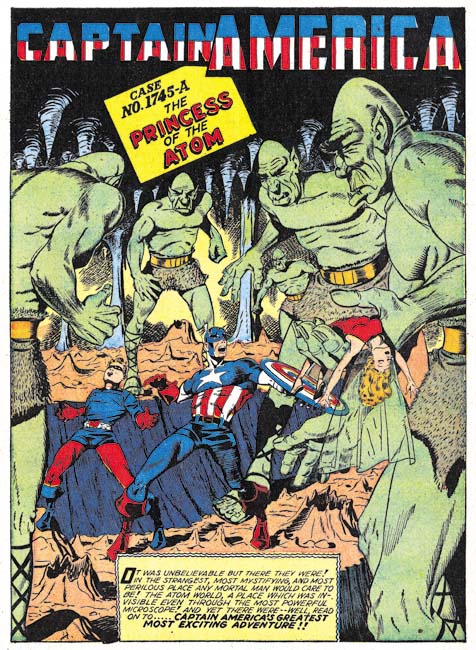
Captain America #25 (April 1943), “The Princess of the Atom”, pencils by Syd Shores
Captain America stories could be quite lengthy with 20 page stories not being at all unusual. However “The Princess of the Atom” is quite exceptional in being a two part story; the only one I am aware of from Captain America Comics. With a combined length of 46 pages it is effectively a comic book novella. It is an imaginative and captivating story and could have replaced “Red Skull’s Deadly Revenge” as my favorite post S&K Captain America story if not for the fact that I have never been able to read the second part. Atlas Tales lists Ray Cummings as the writer of this story. Apparently it is a recycle of his novel “The Girl in the Golden Atom”. This is welcome information as so few golden age comic stories can be attributed to a specific writer.
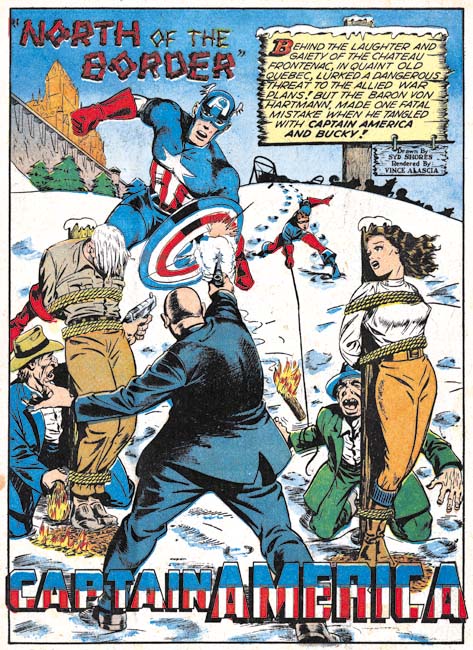
Captain America #27 (June 1943), “North of the Border”, pencils by Syd Shores, inks by Vince Alascia (signed)
Another example of Syd Shores inked by Vince Alascia. A classical triangular composition with Cap at the apex. However the triangle is offset from the center to allow the placement of the caption which is rendered as a wooden sign.
I do not have access to all the Captain America issues, but #22 lists Stan Lee as the Editorial and Art Director and Syd Shores as Associate, #25 provides no credits and #27 lists Vince Fago as the Managing Editor with Syd Shores continuing as the Associate Editor. Stan Lee had started his military service. Normally an artists entering the military would be considered a period where his contributions to comics would end. Simon and Kirby created a backup of material for DC but I am unaware of any other artist doing that. I could swear that I have seen a story with PFC Stan Lee credits (Private First Class) however I have been unable to relocate the source of that information.
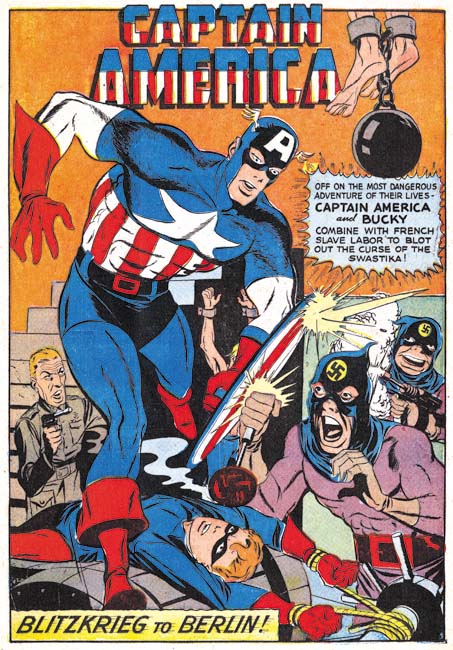
Captain America #27 (June 1943), “Blitzkrieg to Berlin”, pencils by unidentified artist
When Al Avison was the primary artist he seemed to draw most if not all the Captain America stories. But that does not seem to have been the case when Syd Shores became lead artist. Other artists sometimes did the backup Captain America stories and it seems they did so more often in later years. “Blitzkrieg to Berlin” is an example of one artist who appeared to have done a number of Cap stories. Note the very different figure proportions, the simpler faces and the much larger rendering of Captain America as compared to Syd Shores. Other than Shores most of the Cap artists did not sign their work so it is not clear who did this art.
“Blitzkrieg to Berlin” is one the few stories from the period covered in this chapter that I have seen where Captain America actually goes to war although in this case he joins up with some French resistance fighters. A Timely Bonus provides another example at Cap fighting in the war. As before Captain America was much busier combating spies than playing the part of a super soldier.
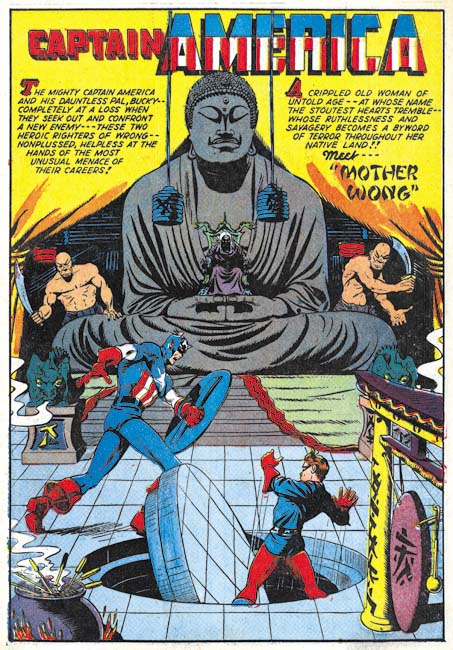
Captain America #33 (December 1943), “Mother Wong”, pencils by Syd Shores
While unsigned “Mother Wong” appears to be the work of Syd Shores and Vince Alascia. I do love these Captain America splashes. With the exception of a few double page spreads the splashes are invariably take up a full page. These generous splashes were put to great use by the creative talents of Avison and Shores. Even some of the backup artists could be quite impressive.

Captain America #34 (January 1944), “The Cult of the Assassins”, pencils by Syd Shores, inks by Vince Alascia, script by Zac Gabel (signed)
Writer credits, other than for Stan Lee, are so rarely provided that a special note is warranted for the credit to Zac Gabel provide in the splash of “The Cult of the Assassins”. Unfortunately very little is known about Gabel. All I have been able to find so far is that Who’s Who lists him as doing work for Holyoke as well (Blue Beetle, Green Mask and the Grey Mask). One wonders if he is the same Zac Gable who wrote the play “Horse Fever” (November 23 to December 14, 1940)?
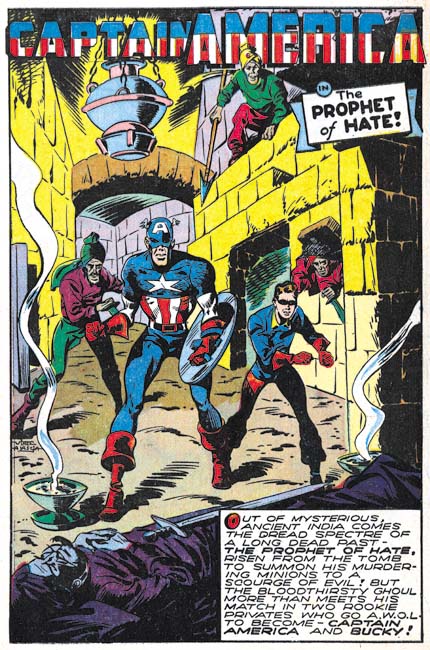
Captain America #44 (January 1945), “The Prophet of Hate”, pencils by Vince Alascia (signed)
Vince Alascia inked most, if not all, of Syd Shore’s art but he was a penciller as well. Vince was not as talented draftsman as Syd but his work still was interesting. Note the background figures threatening Captain America and Bucky. This sort of motif was often used by Simon and Kirby. Since this was a device not used by Avison or Shores it seems reasonable to assume that Alascia had seen and admired Joe and Jack’s work. The inking is done by a blunt brush very different from the inking that Alascia used on Shore’s pencils. Was it inked by someone else or did Alascia adopt a finer inking style to satisfy Shore?

Captain America #47 (June 1945), “The Monster of the Morgue”, pencils by Vince Alascia
“The Monster of the Morgue” is unsigned but the style looks the same as that Vince Alascia used for “The Prophet of Hate” so I attribute this work to him as well. This splash also has a figure with a weapon in the background a motif often used by Simon and Kirby.
I do not have access to many Captain America Comics from this period and it will be probably be years before Marvel’s golden age archives reaches up to the end of the war. Nonetheless next week I hope to discuss Captain America from the period just following the war.


If you don’t have the revival issues from 1954, they seem to be online in Marvel’s digital collection.
I’m very much enjoying this series. What stands out for me are the artists’ use of a Simon and Kirby-derived style, and the quality of their work; all those splashes are nicely drawn.
The only Golden Age Captain America story from after Simon and Kirby’s departure that I’ve seen is the Reaper one from Captain America Comics #22. It was reprinted in the 70s in Invaders #10.
I’ll have to pick up that issue of Invaders. But if it was from the 70’s chances are that the art was altered. Of course art was altered so as to adhere to the Comic Code but sometimes for other reasons as well.